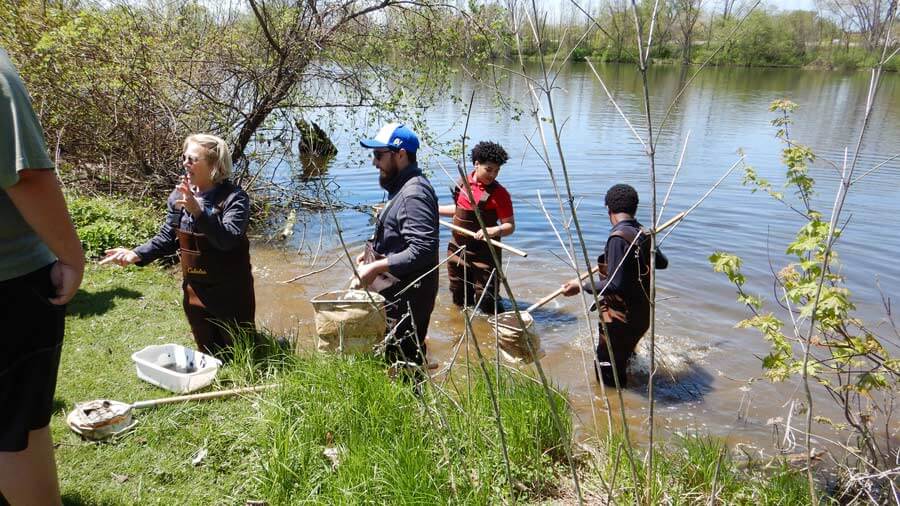As a grade school student, I often struggled sitting in a classroom for hours each day. Hands-on science activities were fun and broke up the day. Field trips and going outside always helped me see the world in a different way. Growing up in Midland, MI, I was fortunate to have the Chippewa River as my backyard playground where every year on the last day of school we jumped into the river — kicking off the summer season of swimming, fishing, canoeing and exploring.
I didn’t realize it at the time, but the river was much more than just my playground, it was also an outdoor classroom that quietly taught me to respect the raw power of Mother Nature and it unlocked my passion for being outdoors. While I was privileged to have this resource in my backyard, at the time I lacked the understanding to know that I could turn my passion for the outdoors into a viable career.
If someone had told me during that last summer of my senior year in high school that I could make a living fishing and playing in the river, I would have laughed at them. After all, playing with fish, clams and mud isn’t really as glamorous or as prestigious as a career in the medical field or in a law firm. Or is it?
Like the river itself, the efforts to restore and revitalize the Grand River have evolved over the last ten years and several local project partners and stakeholders have embraced the educational opportunities provided by this project. The reality is that over the last decade a number of experts from many different fields have been diligently working to define how the Grand River will look, feel, sound and function for generations to come. We have been fortunate to work with some very talented and dedicated biologists, hydraulic modelers, historians, malacologists, engineers, natural resource and conservation professionals, mayors and politicians, construction managers, teachers, nonprofit professionals, grant writers, city managers and city planners, and attorneys guiding us along this path. This project is truly a community effort.
The revitalization of the Grand River presents endless opportunities for educating our community: children and adults alike. Not only can we teach about the river and its unique history and ecosystem, but we have an opportunity to use this river to expose students to careers in conservation and natural resource management.
In a 2019 MLIVE Grand Rapids Press Article, John Helmholdt, Executive Director of Communications & External Affairs for Grand Rapids Public Schools (GRPS), estimates that up to 80-85 percent of GRPS students in the 5th Grade have never seen Lake Michigan. Helmholdt states, “Some students in the city have barely been outside their own city or neighborhood.”
The Grand River is Michigan’s largest river and plays a critical role in the ecosystem of the Great Lakes, specifically Lake Michigan and Lake Huron. That’s why we were excited to partner with the Grand Rapids Public Museum (GRPM) and the Lower Grand River Organization of Watersheds (LGROW) in 2018 to launch the Grand Rapids Whitewater Summer Science and Leadership Program. Our goal was simply to use the Grand River to provide a place-based learning experience that connects students to the world around them and helps them see first-hand how their actions today can change the future of our environment. Read Little Mussel, Big City for a first-hand account of the summer science and leadership program.
We are also thrilled to see more organizations in West Michigan realizing the educational potential of this project. For example, LGROW is working with other partners in the Grand Rapids Environmental Education Network (GREEN) to provide consistent, connected, hands-on environmental education experiences aligned with the curriculum for all Pre-K through 8th grade students in Grand Rapids Public Schools.
LGROW and the Grand Rapids Public Museum are working together to pilot an 8th grade program titled The Living Grand to help students learn about the complexities involved in the process of river restoration, including river management that addresses water quality, invasive species and threatened/endangered species such as the snuffbox mussel.
LGROW also worked with GVSU-Groundswell and Brenda Perry at Kent Innovation High to develop curriculum aligned to science and social studies standards for grades 6-12 around the Grand River Revitalization. That curriculum is available on LGROW’s website at www.lgrow.org/youth-education-programs and at https://www.gvsu.edu/groundswell/lesson-plans-54.htm
Grand Rapids Public Schools, Grand Rapids Parks and Recreation Department and other local private funders have also teamed up in the past to bring the Canoemobile program to Grand Rapids. According to the Wilderness Inquiry website, “Canoemobile is a ‘floating classroom’ that brings students out on local waterways in 24-foot Voyageur canoes to learn about science, history, geography and culture.” This amazing partnership has put over 1,000 GRPS students on the Grand River each year. For many of these students, it is their first time in a canoe or their first hands-on experience with the Grand River.
Grand Rapids Whitewater is thankful for the many great local organizations and educators who have embraced the idea of connecting local students to their Grand River. Our investment of time and energy in these students today, will undoubtedly help raise the next generations of Grand River stewards.
Watching a young student nervously put on a pair of waders and slip into a river or stream is exciting. It reminds me of the joy I felt in my backyard river playground and the excitement of having an outdoor classroom. For those who have not been around water or wildlife growing up, it can be nerve-racking. However, it doesn’t take long before their natural curiosity helps them overcome fears and they start seeing the things that make up the world around them in a different light. The “icky” and “gross” quickly become “amazing” and “cool.”
